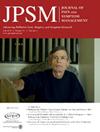Timely Documentation of CPR Codes and Medical Treatment Preferences in the EHRs of Nursing Homes
IF 3.5
2区 医学
Q2 CLINICAL NEUROLOGY
引用次数: 0
Abstract
Context
Timely documentation of cardiopulmonary resuscitation (CPR) code and medical treatment preferences in electronic health records (EHR) is important for translating advance care planning conversations into actionable medical orders.
Objectives
To examine documentation rates of CPR code and medical treatment preferences within the recommended first six weeks of admission in Dutch nursing homes (NHs) from 2017 to 2022.
Methods
This retrospective cohort used EHR from 74 Dutch NHs. We assessed the prevalence of documented CPR codes and medical treatment preferences within six weeks of admission, and the median days until first documentation. To examine whether timely documentation odds improved annually, logit generalized estimating equation models -accounting for clustering of residents within NHs– were used, stratified by NH care type, and adjusted for resident factors.
Results
We included 163,180 residents. CPR code and medical treatment preferences was documented within 6 weeks of admission for 88% and 64% of the residents, respectively. The median time to first documentation were 0.5-2 days across care types. Overall, between 2017 and 2022, timely documentation of CPR code increased from 82% to 92% and for medical treatment preferences from 56% to 70%. Recent admission year was associated with higher odds of timely documentation for both type of orders in psychogeriatric and somatic care, and for CPR in rehabilitation care.
Conclusion
Most residents had documented CPR code and medical treatment preference within the recommended six weeks of admission, with rates improving from 2017 to 2022. The improvement coincided with a national quality indicator introduced in 2018 and the COVID-19 pandemic.
疗养院电子病历中心肺复苏术编码和医疗偏好的及时记录。
背景:在电子健康记录(EHR)中及时记录心肺复苏(CPR)代码和医疗偏好对于将预先护理计划对话转化为可操作的医疗命令非常重要。目的:研究2017年至2022年荷兰养老院(NHs)推荐的入院前六周内CPR代码的记录率和医疗偏好。方法:本回顾性队列研究使用74个荷兰NHs的电子病历。我们评估了入院六周内记录的CPR代码和医疗偏好的流行程度,以及首次记录的中位数天数。为了检查及时记录的几率是否每年都有所提高,使用logit广义估计方程模型(考虑NHs内居民的聚类),按NH护理类型分层,并根据居民因素进行调整。结果:我们纳入了163,180名居民。分别有88%和64%的居民在入院后6周内记录了CPR代码和医疗偏好。所有护理类型到首次记录的中位时间为0.5-2天。总体而言,在2017年至2022年期间,及时记录CPR代码从82%增加到92%,医疗偏好从56%增加到70%。最近的入院年份与老年心理和躯体护理的两种类型的订单以及康复护理中的心肺复苏术的及时记录的几率较高相关。结论:大多数居民在入院后6周内记录了CPR代码和医疗偏好,2017年至2022年期间,这一比例有所提高。这一改善与2018年引入的国家质量指标和2019冠状病毒病大流行相吻合。
本文章由计算机程序翻译,如有差异,请以英文原文为准。
求助全文
约1分钟内获得全文
求助全文
来源期刊
CiteScore
8.90
自引率
6.40%
发文量
821
审稿时长
26 days
期刊介绍:
The Journal of Pain and Symptom Management is an internationally respected, peer-reviewed journal and serves an interdisciplinary audience of professionals by providing a forum for the publication of the latest clinical research and best practices related to the relief of illness burden among patients afflicted with serious or life-threatening illness.

 求助内容:
求助内容: 应助结果提醒方式:
应助结果提醒方式:


